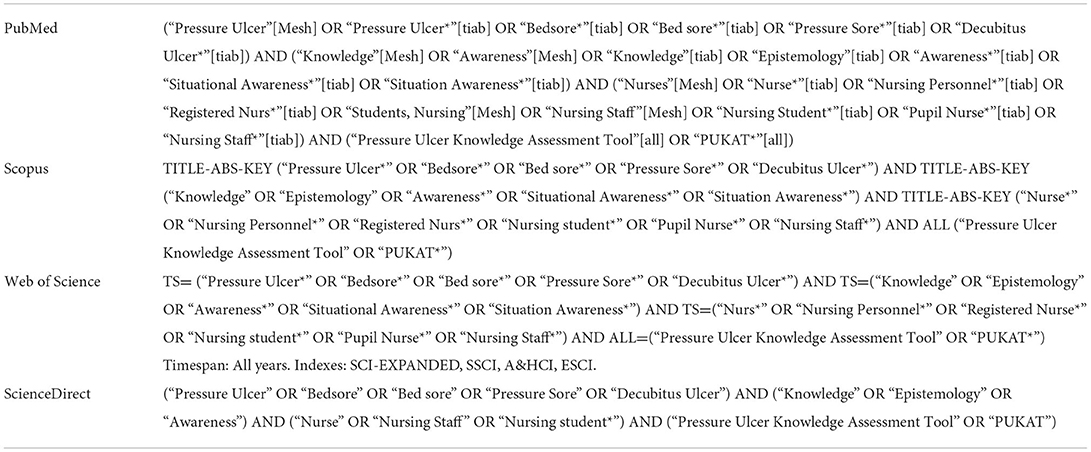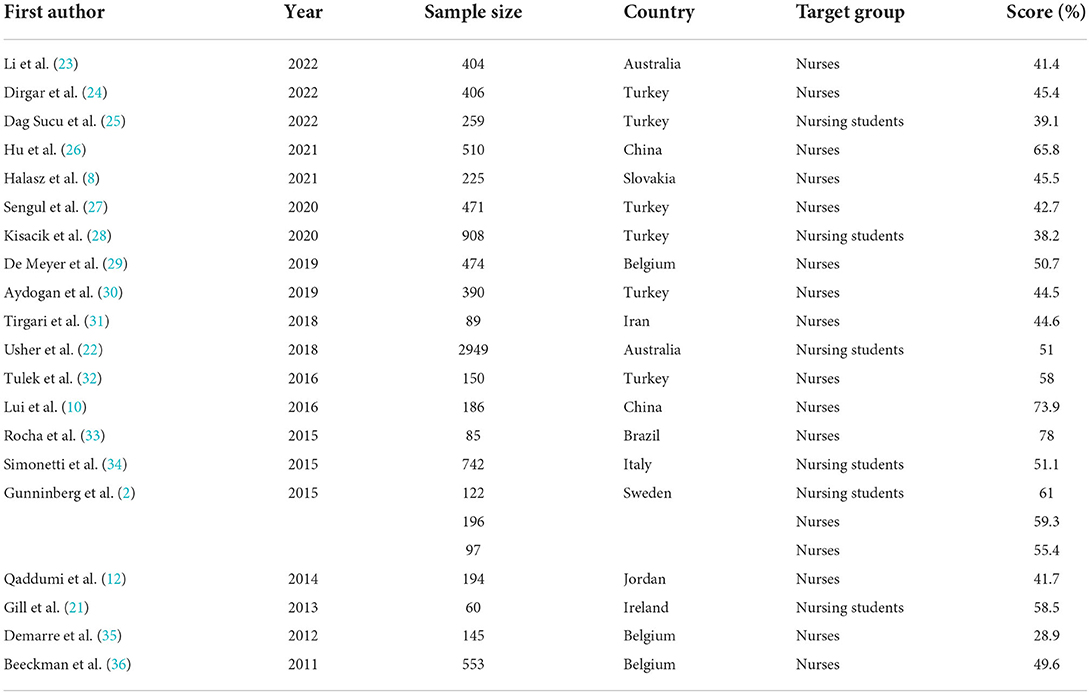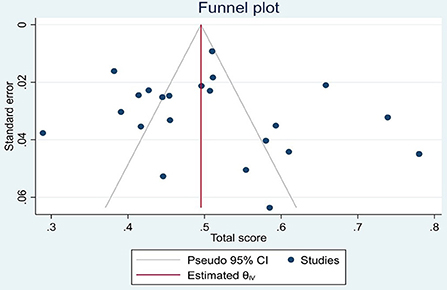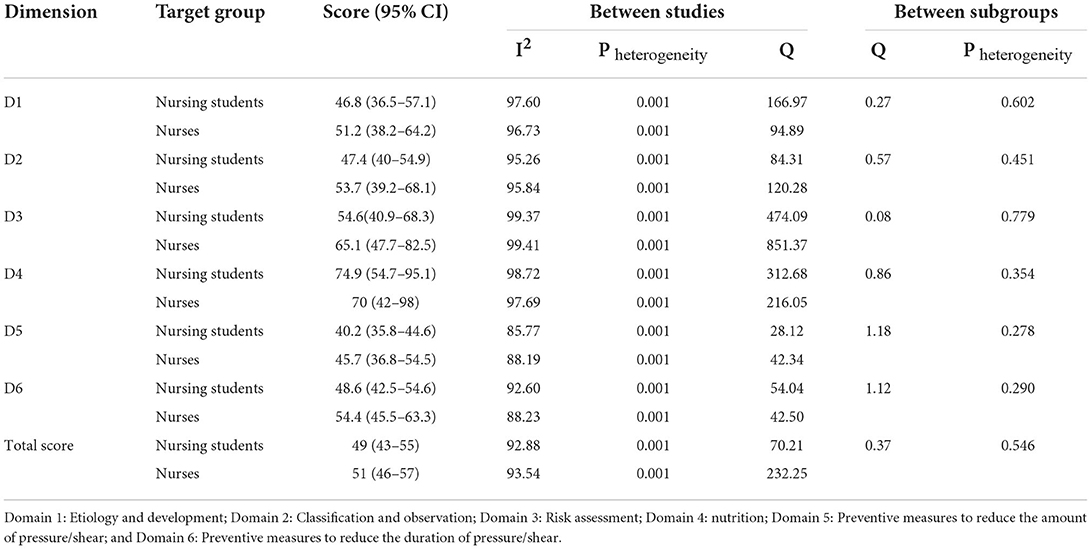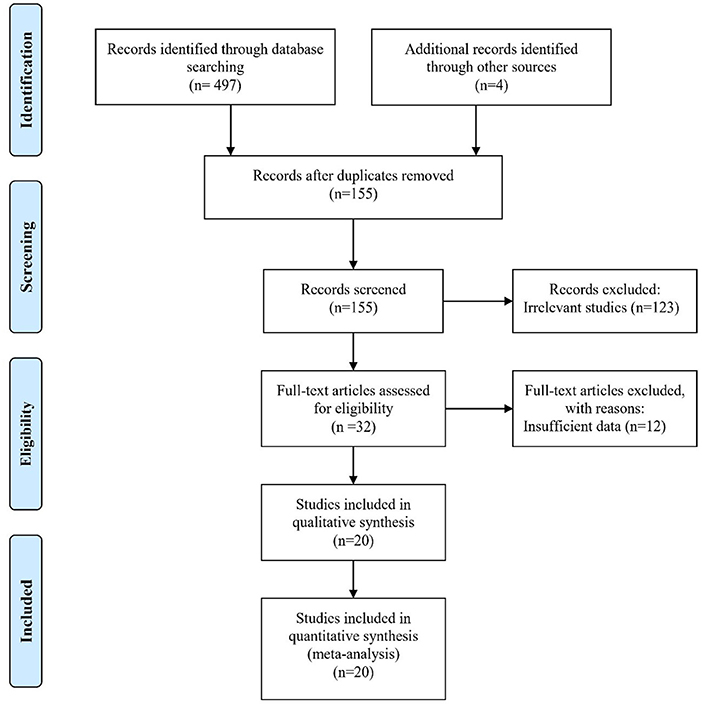- 1Department of Pediatric Hematologic Oncology Nursing, West China Second University Hospital, Sichuan University, Chengdu, China
- 2Key Laboratory of Birth Defects and Related Diseases of Women and Children, Ministry of Education, Sichuan University, Chengdu, China
- 3Department of Obstetrics and Gynecology, Mianyang Central Hospital, Mianyang, China
Background: Pressure ulcers (PUs) are an indicator of the quality of nursing care and nurses can prevent PUs well if they have sufficient knowledge. Numerous studies in this field have reported different results. The aim of this study was to estimate the pooled score of nurses' knowledge about PU prevention based on the Pressure Ulcer Knowledge Assessment Tool (PUKAT).
Methods: In this systematic review and meta-analysis, databases including Web of Science, ScienceDirect, PubMed, and Scopus were searched. All studies published in English between 2011 and 2022 that reported the status of nurses' knowledge of PU prevention based on PUKAT were included in the analysis. Based on heterogeneity between the studies, the data were analyzed using a random effects model.
Results: The pooled scores of PU prevention knowledge in nurses and nursing students were (51.5%; 95% CI: 45.8–57.2%) and (48.9%; 95% CI: 42.5–55.2%), respectively. As the age of the participants increased, the pooled score of pressure ulcer prevention knowledge increased significantly (p = 0.028). The publication bias was not significant. The highest and lowest knowledge scores in nurses and nursing students were related to the fourth dimension (nutrition) and the fifth dimension (preventive measures to reduce the amount of pressure/shear), respectively.
Conclusion: Knowledge of nurses and nursing students about PU prevention is insufficient. Providing regular training to nurses and including the principles of PU prevention in the curriculum of nursing students to improve their knowledge seems necessary.
Introduction
Pressure ulcer (PU) is a localized lesion on the skin and/or underlying tissue that often occurs on bony prominences due to pressure or pressure in combination with shear and/or friction forces (1). Most PUs are avoidable; however, the prevalence of PUs remains high (2). The burden of PUs is so high that some regulatory bodies have set goals to reduce the number of patients, and others have introduced financial penalties and/or incentives schemes to reduce the development of PUs (3, 4). The prevalence of PU is mentioned as an indicator of the quality of hospital care, which is widely accepted as a nursing-sensitive measure (5). In addition to causing suffering and reducing the quality of life of patients, PUs are associated with high costs of health care and prolonged nursing care (6, 7), and can lead to life-threatening situations (8).
Social exclusion, malodor, fluid leakage, pain, immobility, loss of independence, and changes in body image all affect the quality of life of these patients (9, 10). Nurses are responsible for providing safe prevention of PUs in at-risk patients (11), but it is often seen that they have poor adherence to pressure ulcer prevention guidelines, which may be due to their lack of knowledge (12). Sometimes nurses are not fully aware of the importance of using up-to-date PU prevention protocols or may not be exposed to current trends. Therefore, instead of using evidence-based methods, they take preventive measures based on intuition, experience, or habit (13).
PU prevention is very important because 95% of all PUs are preventable, therefore, nurses who work in clinical settings and are in daily contact with people at high risk for PU should have adequate knowledge level and a positive attitude (14, 15). Insufficient knowledge and skills in PU prevention can increase or exacerbate the chances of developing PUs, so nurses need regular training in this area (12). Improving nurses' knowledge of PU prevention not only improves the quality of PU care, but also reduces the length of hospital stay and the number of patients suffering from pressure ulcers (16). Knowledge of PU prevention helps nurses better decide which patients should receive prevention, which prevention should be applied, and how prevention must be applied (17).
Despite the importance of PU prevention and the development of international evidence-based guidelines, various studies on nurses' knowledge of risk assessment and PU prevention have shown different results. In a systematic review study, Dalvand et al. (18) examined nurses' knowledge of PU prevention. They reviewed eight eligible studies and concluded that the knowledge of nurses and nursing students in this field is still insufficient (18). Therefore, it is necessary to systematically review the results of all related studies and estimate the level of knowledge of nurses about pressure ulcer prevention. The aim of this updated systematic review and meta-analysis was to estimate the pooled score of nurses' knowledge about pressure ulcer prevention based on the Pressure Ulcer Knowledge Assessment Tool (PUKAT).
Methods
In this systematic review and meta-analysis, the level of nurses' knowledge about PU prevention was estimated based on PUKAT and according to preferred reporting items for systematic reviews and meta-analyses (PRISMA) guidelines (19).
Search strategy
In this study, the knowledge scores of nurses and nursing students were evaluated in articles published in English based on PUKAT. To search was conducted in PubMed, Scopus, ScienceDirect, and Web of Science using the following keywords: pressure ulcer, bedsore, pressure sore, decubitus ulcer, knowledge and all their possible combinations were searched. The references of the selected articles were also reviewed for access to other articles. Also, in Google Scholar, all the articles that cited the main article (development and validation of PUKAT) were reviewed. Considering that the PUKAT was developed and validated in 2011, databases were searched from 2011 to 2022. The search results of the mentioned databases are presented in Table 1.
Selection of studies and data extraction
Initially, the two researchers independently screened articles based on title and abstract, eliminating irrelevant studies. Then the full text of the remaining articles was read, and studies that did not report the required information were excluded from the analysis based on inclusion and exclusion criteria. The inclusion criteria were: conducting a study on nurses or nursing students, using PUKAT to measure the knowledge of pressure ulcer prevention, reporting the overall score or the score of different dimensions of knowledge, and publishing in English. Eligible articles were reviewed by two independent researchers and the necessary information such as the first author, year of publication, sample size, target group, total score of knowledge, and score of different dimensions of knowledge were extracted and recorded in the pre-prepared form. Studies that did not report essential information, whose full text was not available, or measured knowledge based on other tools were excluded from the analysis. In all stages of reviewing and evaluating the articles, any disagreements were resolved through consultation.
The Pressure Ulcer Knowledge Assessment Tool
The PUKAT was developed by Beeckman et al. (17) and includes 26 questions and 6 dimensions: (1) etiology and development, (2) classification and observation, (3) nutrition, (4) risk assessment, (5) reduction of the magnitude of pressure and tearing, and (6) reduction of the duration of pressure and shearing. Each question has multiple answers, one of which is correct and the rest are incorrect. The correct answer is given a score of “1” and the incorrect answers are given a score of “zero”. The overall score and the score of each dimension are reported as a percentage. The final score varies between zero and 26, a higher score indicates more knowledge. Achieving more than 60% of the knowledge score indicates a sufficient level of knowledge (17).
Quality assessment
The strengthening the reporting of observational studies in epidemiology (STROBE) checklist was used to evaluate the methodological quality of the selected articles. Based on the nature and purpose of the study, 10 items were selected from this checklist and selected articles were evaluated based on them. If those items were observed in the analyzed articles, they would be given a score of 1 and otherwise it would be given a score of zero. Therefore, the final score ranges from 0 to 10, and a higher score indicates a better quality (20). Based on the score of this checklist, the articles were divided into three categories: weak (score less than 4), medium (4 to 7), and strong (above 7).
Statistical analysis
In these studies, the total knowledge score and its dimensions were expressed as a percentage, so we used a binomial distribution to estimate the pooled score and its dimensions. The I2 index and the Cochrane Q test were used to examine the heterogeneity between the selected studies. Considering that I2 index was more than 75% (I2 value > 75% is considered as high heterogeneity) and Cochran Q test was also significant (significance level for this test was considered 0.1), random effects model was used to combine selected studies and estimate the percentage of scores. Forrest Plot was used to visually display selected studies in terms of effect size and 95% confidence interval. Because nursing students' curricula may not have educational material on chronic wounds or may be limited, they could not be grouped with nurses who have experience working in the clinic and dealing with these wounds. Therefore, subgroup analysis was presented separately for the target groups (nursing students and nurses). Also, considering that in selected studies, the level of knowledge was measured based on two versions PUKAT 1 and PUKAT 2, we reported the results separately based on the version used.
Meta-regression analysis was used to examine the relationship between the year of publication, sample size and mean age of participants. To evaluate the effect of small studies and potential publication bias, funnel plot based on Egger regression test was used. All analyzes were performed using STATA software version 16.
Results
In this study, all published studies that examined the knowledge of nurses and nursing students about the prevention of pressure ulcers (based on PUKAT) were reviewed. Because the PUKAT was designed by Beckman et al., (17), studies between 2011 to 2022 were included in the analysis. In the initial search, 501 studies were identified and 481 studies were excluded from the final analysis based on inclusion and exclusion criteria (Figure 1).
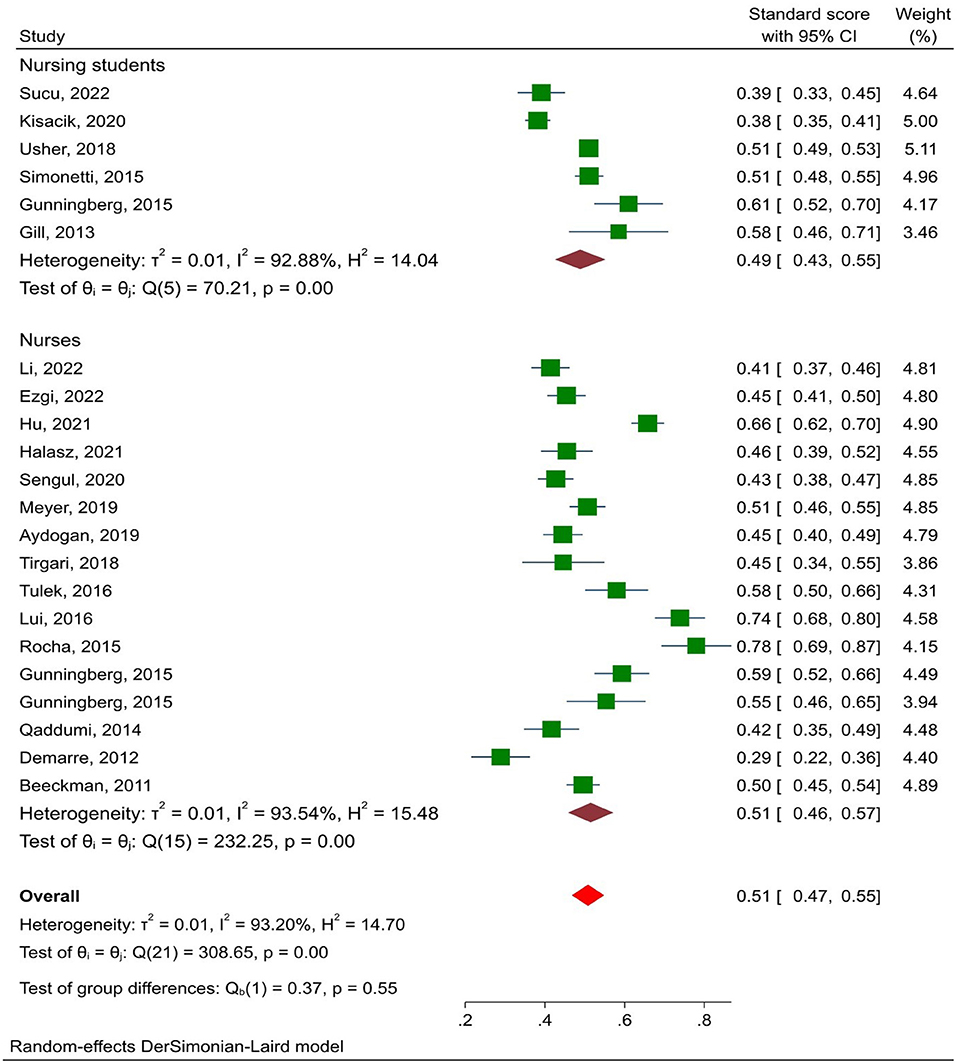
Figure 1. Screening flowchart showing the selection of qualified articles according to the PRISMA statement.
In this systematic review, 20 eligible studies were included in the analysis. The studies were conducted between 2011 and 2022. The study of Gunningberg et al. was performed on nurses and nursing students and the details of the dimensional score were reported separately (2). Another 5 studies were performed on nursing students and 14 studies were performed on nurses. Most of the studies were related to Turkey (n = 6). The highest and lowest sample sizes were related to the studies of Usher et al. and Gill et al., respectively (21, 22). None of the selected articles had low methodological quality. More details are given in Table 2. PUKAT 2 was used in three articles, all of which were performed on nurses. Also, in all studies conducted on nursing students, the level of knowledge was measured based on PUKAT 1.
The pressure ulcer prevention knowledge score was 51% (95% CI: 47–55%). The results of subgroup analysis by target population showed that the knowledge scores of nurses and nursing students were (51.5%; 95% CI: 45.8–57.2%) and (48.9%; 95% CI: 42.5–55.2%), respectively (Figure 2). In three studies, the second version of the PUKAT was used, which had 28 questions instead of 26. The knowledge score based on the PUKAT 1 and PUKAT 2 was 50.5% (95% CI: 46.2–54.7%) and 52.7% (95% CI: 38.5–66.8%), respectively (p = 0.769). Also, nurses and nursing students did not have significant differences in any of the dimensions of PUKAT.
The highest score of pressure ulcer prevention knowledge in both groups of nurses (70%, 95% CI: 42–98) and nursing students (74.9%, 95% CI: 54.7–95.1) was related to the fourth dimension (nutrition). Nurses (45.7%, 95% CI: 36.8–54.5) and nursing students (40.2%, 95% CI: 35.8–44.6) also had the lowest scores in the fifth dimension (preventive measures to reduce the amount of pressure/shear) (Table 3).
The results of meta-regression showed that there was no relationship between the score of PU prevention knowledge with the year of publication (p = 0.30) and sample size (p = 0.632), but with age, the knowledge of PU prevention increased significantly (p = 0.028). Also, publication bias was not significant (p = 0.220) (Figure 3).
Discussion
The knowledge scores of nurses and nursing students were 51.5 and 48.9%, respectively. Considering that obtaining more than 60% of the score indicates appropriate knowledge, the results of this study show that the knowledge of nurses and nursing students about the prevention of PU is insufficient. In the systematic review of Dalvand et al. the knowledge of nurses and nursing students was 55.4 and 52.7%, respectively, which is consistent with the results of the present study and emphasizes that the knowledge of pressure ulcer prevention has not yet been sufficient (18). The results of a study showed that neither nurses nor nursing students knew that the main cause of PUs was lack of oxygen in the tissue (2). It seems that until nurses do not have clear information about the root cause of PUs, patients cannot hope to receive evidence-based prevention measures.
The highest score of knowledge in nurses and nursing students was related to nutrition, which is exactly in line with the results of meta-analysis of Dalvand et al. (18). This finding may be due to the small number of questions in this dimension or the simplicity of these questions compared to other questions. A recent systematic review and meta-analysis concluded that high-protein oral supplements reduced the effects of PUs and hospitalization (37). However, dietary supplements cannot replace pressure reduction to prevent PU. The lowest knowledge score in nurses and nursing students was related to the fifth dimension. This dimension of knowledge of nurses and nursing students refers to such things as changing positions, positions that reduce the risk of pressure ulcers, scheduling changes in the patient lying on visco-elastic foam, and the disadvantages of water mattresses and common sites of pressure ulcers. In the study by Schoeps et al., most nurses did not follow pressure ulcer prevention strategies such as changing positions (38). The results of the study by Mwebaza et al. showed that one-third of the nurses did not observe their bodies for the presence of pressure ulcers during the admission of patients, so the presence of pressure ulcers was ignored (39). In this study, with increasing age, knowledge score increased significantly. Given that the mean age of nurses is higher than nursing students, this finding is acceptable. Due to the lack of relationship between knowledge score and the year of publication of studies, it can be stated that between 2011 and 2022, the knowledge score of nurses and nursing students in the field of PU prevention has not changed significantly. One of the limitations of this study is that the assessment of nurses' knowledge based on PUKAT tools is only able to measure declarative knowledge and does not examine high levels of knowledge such as analysis, synthesis and evaluation. Another limitation of this study was the high heterogeneity, which indicates that the published studies are heterogeneous and not all conducted in the same direction. Therefore, it is suggested to conduct cohort studies with a large sample size in this field in the future.
Conclusion
The results of this study showed that the knowledge of nurses and nursing students about the PUs prevention is insufficient and until the level of their knowledge reaches an acceptable level, the prevalence of PUS cannot be expected to decrease significantly. Accordingly, providing the necessary training to nurses and allocating part of the curriculum of nursing students to the principles of PU prevention can be helpful. Due to the low score of knowledge of both nurses and nursing students in the fifth dimension of PUKAT 1, providing the necessary explanations about “preventive measures to reduce the amount of pressure/shear” to improve this section will improve their overall knowledge.
Data availability statement
The original contributions presented in the study are included in the article/supplementary material, further inquiries can be directed to the corresponding author/s.
Author contributions
JW and BW extracted and analyzed the synthesized data and made a major contribution in writing the manuscript from overall and data analytical perspective. LZ and XJ interpreted data. All authors read and approved the final manuscript.
Conflict of interest
The authors declare that the research was conducted in the absence of any commercial or financial relationships that could be construed as a potential conflict of interest.
Publisher's note
All claims expressed in this article are solely those of the authors and do not necessarily represent those of their affiliated organizations, or those of the publisher, the editors and the reviewers. Any product that may be evaluated in this article, or claim that may be made by its manufacturer, is not guaranteed or endorsed by the publisher.
Abbreviations
PRISMA, Preferred reporting items for systematic reviews and meta-analyses; PU, Pressure ulcers; PUKAT, Pressure Ulcer Knowledge Assessment Tool; STROBE, The strengthening the reporting of observational studies in epidemiology.
References
1. Akhkand SS, Seidi J, Ebadi A, Gheshlagh RG. Prevalence of pressure ulcer in Iran's intensive care units: A systematic review and meta-analysis. Nursing Pract Today. (2020) 7:21–9. doi: 10.18502/npt.v7i1.2296
2. Gunningberg L, Mårtensson G, Mamhidir AG, Florin J, Muntlin Athlin Å, Bååth C. Pressure ulcer knowledge of registered nurses, assistant nurses and student nurses: a descriptive, comparative multicentre study in Sweden. Int Wound J. (2015) 12:462–8. doi: 10.1111/iwj.12138
3. Gunningberg L, Hommel A, Bååth C, Idvall E. The first national pressure ulcer prevalence survey in county council and municipality settings in Sweden. J Eval Clin Pract. (2013) 19:862–7. doi: 10.1111/j.1365-2753.2012.01865.x
4. Lyder CH, Ayello EA. Pressure ulcer care and public policy: exploring the past to inform the future. Adv Skin Wound Care. (2012) 25:72–6. doi: 10.1097/01.ASW.0000411407.20801.96
5. Brown DS, Donaldson N, Burnes Bolton L, Aydin CE. Nursing-sensitive benchmarks for hospitals to gauge high-reliability performance. J Healthcare Quality. (2010) 32:9–17. doi: 10.1111/j.1945-1474.2010.00083.x
6. Bennett G, Dealey C, Posnett J. The cost of pressure ulcers in the UK. Age ageing. (2004) 33:230–5. doi: 10.1093/ageing/afh086
7. Charalambous C, Koulouri A, Roupa Z, Vasilopoulos A, Kyriakou M, Vasiliou M. Knowledge and attitudes of nurses in a major public hospital in Cyprus towards pressure ulcer prevention. J Tissue Viability. (2019) 28:40–5. doi: 10.1016/j.jtv.2018.10.005
8. Grešš Halász B, Bérešová A, Tkáčová L, Magurová D, Lizáková L. Nurses' knowledge and attitudes towards prevention of pressure ulcers. Int J Environ. Res Public Health. (2021) 18:1705. doi: 10.3390/ijerph18041705
9. Clark M. Pressure ulcers and quality of life. Nurs Stand. (2002) 16:74. doi: 10.7748/ns2002.02.16.22.74.c3156
10. Liu M, Yuan H-B, Chen W-J, Poon C, Hsu M, Zhang B. Translation, modification and validation of the Chinese version of a knowledge assessment instrument regarding pressure ulcer prevention. Chinese Nurs Res. (2016) 3:16–23. doi: 10.1016/j.cnre.2015.12.002
11. Sving E, Gunningberg L, Högman M, Mamhidir AG. Registered nurses' attention to and perceptions of pressure ulcer prevention in hospital settings. J Clin Nurs. (2012) 21:1293–303. doi: 10.1111/j.1365-2702.2011.04000.x
12. Qaddumi J, Khawaldeh A. Pressure ulcer prevention knowledge among Jordanian nurses: a cross-sectional study. BMC Nurs. (2014) 13:1–8. doi: 10.1186/1472-6955-13-6
13. Gunningberg L. Pressure ulcer prevention: evaluation of an education programme for Swedish nurses. J Wound Care. (2004) 13:85–9. doi: 10.12968/jowc.2004.13.3.26587
14. Moore Z, Price P. Nurses' attitudes, behaviours and perceived barriers towards pressure ulcer prevention. J Clin Nurs. (2004) 13:942–51. doi: 10.1111/j.1365-2702.2004.00972.x
15. Gunningberg L, Lindholm C, Carlsson M, Sjödén PO. Risk, prevention and treatment of pressure ulcers–nursing staff knowledge and documentation. Scand J Caring Sci. (2001) 15:257–63. doi: 10.1046/j.1471-6712.2001.00034.x
16. Smith D, Waugh S. Research study: an assessment of registered nurses' knowledge of pressure ulcers prevention and treatment. Kansas Nurse. (2009) 84:3.
17. Beeckman D, Vanderwee K, Demarré L, Paquay L, Van Hecke A, Defloor T. Pressure ulcer prevention: development and psychometric validation of a knowledge assessment instrument. Int J Nurs Stud. (2010) 47:399–410. doi: 10.1016/j.ijnurstu.2009.08.010
18. Dalvand S, Ebadi A, Gheshlagh RG. Nurses' knowledge on pressure injury prevention: a systematic review and meta-analysis based on the Pressure Ulcer Knowledge Assessment Tool. Clin Cosmet Investigat Dermatol. (2018) 11:613. doi: 10.2147/CCID.S186381
19. Moher D, Liberati A, Tetzlaff J, Altman DG, Group P. Reprint-preferred reporting items for systematic reviews and meta-analyses: the PRISMA statement. Phys Ther. (2009) 89:873–80. doi: 10.1093/ptj/89.9.873
20. Adams AD, Benner RS, Riggs TW, Chescheir NC. Use of the STROBE checklist to evaluate the reporting quality of observational research in obstetrics. Obstetr Gynecol. (2018) 132:507–12. doi: 10.1097/AOG.0000000000002689
21. Gill EC, Moore Z. An exploration of fourth-year undergraduate nurses' knowledge of and attitude towards pressure ulcer prevention. J Wound Care. (2013) 22:618–27. doi: 10.12968/jowc.2013.22.11.618
22. Usher K, Woods C, Brown J, Power T, Lea J, Hutchinson M, et al. Australian nursing students' knowledge and attitudes towards pressure injury prevention: A cross-sectional study. Int J Nurs Stud. (2018) 81:14–20. doi: 10.1016/j.ijnurstu.2018.01.015
23. Li Z, Marshall AP, Lin F, Ding Y, Chaboyer W. Knowledge of pressure injury in medical and surgical nurses in a tertiary level hospital: A cross-sectional study. J Tissue Viabil. (2022) 31:24–9. doi: 10.1016/j.jtv.2021.12.003
24. Dirgar E, Tosun B, Dokumus H, Bülbül T. Evaluating nurses' knowledge of pressure injury prevention: A Descriptive Study. Adv Skin Wound Care. (2022) 35:1–6. doi: 10.1097/01.ASW.0000820108.14315.71
25. Sucu GD, Kilic HF. Knowledge and attitudes of Turkish nursing students towards pressure injury prevention. J Tissue Viabil. (2022) 31:16–23. doi: 10.1016/j.jtv.2021.08.003
26. Hu L, Sae-Sia W, Kitrungrote L. Intensive care nurses' knowledge, attitude, and practice of pressure injury prevention in China: A cross-sectional study. Risk Manag. Healthcare Policy. (2021) 14:4257–67. doi: 10.2147/RMHP.S323839
27. Sengul T, Karadag A. Determination of nurses' level of knowledge on the prevention of pressure ulcers: The case of Turkey. J Tissue Viabil. (2020) 29:337–41. doi: 10.1016/j.jtv.2020.06.005
28. Kisacik ÖG, Sönmez M. Pressure ulcers prevention: Turkish nursing students' knowledge and attitudes and influencing factors. J Tissue Viabil. (2020) 29:24–31. doi: 10.1016/j.jtv.2019.11.003
29. De Meyer D, Verhaeghe S, Van Hecke A, Beeckman D. Knowledge of nurses and nursing assistants about pressure ulcer prevention: A survey in 16 Belgian hospitals using the PUKAT 2.0 tool. J Tissue Viabil. (2019) 28:59–69. doi: 10.1016/j.jtv.2019.03.002
30. Aydogan S, Caliskan N. A descriptive study of turkish intensive care nurses' pressure ulcer prevention knowledge, attitudes, and perceived barriers to care. Wound Manag Prevent. (2019) 65:39–47. doi: 10.25270/wmp.2019.2.3947
31. Tirgari B, Mirshekari L, Forouzi MA. Pressure injury prevention: knowledge and attitudes of Iranian intensive care nurses. Adv Skin Wound Care. (2018) 31:1–8. doi: 10.1097/01.ASW.0000530848.50085.ef
32. Tulek Z, Polat C, Ozkan I, Theofanidis D, Togrol RE. Validity and reliability of the Turkish version of the pressure ulcer prevention knowledge assessment instrument. J Tissue Viabil. (2016) 25:201–8. doi: 10.1016/j.jtv.2016.09.001
33. Rocha LES, Ruas EdF, Santos JAD, Lima C, Carneiro JA, Costa F. Prevention of pressure ulcers: evaluation of nursing professionals knowledge. Cogitare Enferm. (2015) 20:596–604. Available online at: https://docs.bvsalud.org/biblioref/2016/08/1236/41750-162831-1-pb.pdf
34. Simonetti V, Comparcini D, Flacco ME, Di Giovanni P, Cicolini G. Nursing students' knowledge and attitude on pressure ulcer prevention evidence-based guidelines: a multicenter cross-sectional study. Nurse Educ. Today. (2015) 35:573–9. doi: 10.1016/j.nedt.2014.12.020
35. Demarré L, Vanderwee K, Defloor T, Verhaeghe S, Schoonhoven L, Beeckman D. Pressure ulcers: knowledge and attitude of nurses and nursing assistants in Belgian nursing homes. J Clin Nurs. (2012) 21:1425–34. doi: 10.1111/j.1365-2702.2011.03878.x
36. Beeckman D, Defloor T, Schoonhoven L, Vanderwee K. Knowledge and attitudes of nurses on pressure ulcer prevention: a cross-sectional multicenter study in Belgian hospitals. Worldviews Evid Based Nurs. (2011) 8:166–76. doi: 10.1111/j.1741-6787.2011.00217.x
37. Cawood A, Elia M, Stratton R. Systematic review and meta-analysis of the effects of high protein oral nutritional supplements. Aging Res. Rev. (2012) 11:278–96. doi: 10.1016/j.arr.2011.12.008
38. Schoeps LN, Tallberg AB, Gunningberg L. Patients' knowledge of and participation in preventing pressure ulcers-an intervention study. Int Wound J. (2017) 14:344–8. doi: 10.1111/iwj.12606
Keywords: pressure ulcer, prevention knowledge, PUKAT, prevention, knowledge
Citation: Wu J, Wang B, Zhu L and Jia X (2022) Nurses' knowledge on pressure ulcer prevention: An updated systematic review and meta-analysis based on the Pressure Ulcer Knowledge Assessment Tool. Front. Public Health 10:964680. doi: 10.3389/fpubh.2022.964680
Received: 09 June 2022; Accepted: 16 August 2022;
Published: 08 September 2022.
Edited by:
Kourosh Zarea, Ahvaz Jundishapur University of Medical Sciences, IranReviewed by:
Reza Ghanei Gheshlagh, Kurdistan University of Medical Sciences, IranMojtaba Miladinia, Ahvaz Jundishapur University of Medical Sciences, Iran
Copyright © 2022 Wu, Wang, Zhu and Jia. This is an open-access article distributed under the terms of the Creative Commons Attribution License (CC BY). The use, distribution or reproduction in other forums is permitted, provided the original author(s) and the copyright owner(s) are credited and that the original publication in this journal is cited, in accordance with accepted academic practice. No use, distribution or reproduction is permitted which does not comply with these terms.
*Correspondence: Xiaoli Jia, hxeyjxl@sina.com
†ORCID: Xiaoli Jia orcid.org/0000-0001-7586-854X
 Jing Wu1,2
Jing Wu1,2 Xiaoli Jia
Xiaoli Jia